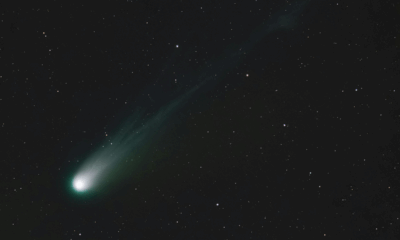Science
Harvard’s Avi Loeb Claims 3I/ATLAS Points to Alien Technology

The scientific community is abuzz following claims from Avi Loeb, an astrophysicist at Harvard University, who suggests that the interstellar object 3I/ATLAS may represent advanced alien technology. Discovered in July 2025, 3I/ATLAS has ignited debate as it approaches its closest point to the Sun on October 29, 2025. While many astronomers categorize the object as a natural comet, Loeb argues that its behavior indicates something far more extraordinary.
Unusual Characteristics of 3I/ATLAS
3I/ATLAS has drawn attention for its unusual properties, particularly its resilience during its perihelion passage. Typically, a comet would disintegrate when subjected to the Sun’s intense heat and tidal forces. Yet, images taken on November 11, 2025, by the Nordic Optical Telescope revealed that 3I/ATLAS remained “an active, single body, with no evidence for breakup following the recent perihelion passage,” according to Loeb’s analysis.
Loeb has calculated that the object’s mass loss rate exceeds what would be expected from a natural comet. He argues that the significant surface area needed to facilitate the energy exchange and mass flow seen in its jets—some extending up to a million kilometers—cannot be supported by a natural formation. He stated that at its closest approach to the Sun, 3I/ATLAS absorbed approximately 700 Joules per square meter per second, necessitating an absorbing area of over 1,600 square kilometers (617 square miles). Loeb contends that this figure is “untenable” for a single intact comet.
The Directional Plumes and Theories
The directionality of 3I/ATLAS’s jets has further complicated its classification. While comet tails typically extend away from the Sun due to solar wind, this object exhibited an “anti-tail” pointing towards the star. Loeb proposed that this could indicate technological thrusters designed to accelerate the object away from the Sun, suggesting a potential spacecraft maneuver. He speculated that a craft might utilize gravitational assists from the Sun to gain speed rather than slow down.
Moreover, 3I/ATLAS is estimated to be about a million times more massive than the first known interstellar object, 1I/’Oumuamua. The detection of nickel emissions without corresponding iron suggests a composition more akin to industrial alloys, which adds to the intrigue surrounding its origins.
Despite these provocative claims, much of the scientific community remains skeptical. Observations from the MeerKAT radio telescope in South Africa have supported a more conventional view, detecting radio absorption lines indicative of cometary activity. This evidence aligns with expectations for a water-rich comet, reinforcing the argument for a natural origin.
Dr. Darryl Seligman, an astronomy professor at Michigan State University, emphasized that 3I/ATLAS’s integrity post-perihelion is consistent with expectations for an object of its size, estimated at approximately 1 kilometer (0.6 miles). Qicheng Zhang from the Lowell Observatory echoed this sentiment, stating that all images show a “stable comet” with no signs of fragmentation.
Although Loeb acknowledges the hydroxyl radical detections, he continues to advocate for transparency and further research through his Galileo Project, which aims to search for extraterrestrial artifacts. As 3I/ATLAS approaches Earth in December 2025, at a distance of approximately 167 million miles, the debate over its true nature—as either a natural celestial body or a manufactured extraterrestrial visitor—underscores humanity’s ongoing quest to understand our place in the cosmos.
-

 Entertainment3 months ago
Entertainment3 months agoAnn Ming Reflects on ITV’s ‘I Fought the Law’ Drama
-

 Entertainment4 months ago
Entertainment4 months agoKate Garraway Sells £2 Million Home Amid Financial Struggles
-

 Health2 months ago
Health2 months agoKatie Price Faces New Health Concerns After Cancer Symptoms Resurface
-

 Entertainment3 months ago
Entertainment3 months agoCoronation Street’s Carl Webster Faces Trouble with New Affairs
-

 Entertainment2 months ago
Entertainment2 months agoWhere is Tinder Swindler Simon Leviev? Latest Updates Revealed
-

 Entertainment4 months ago
Entertainment4 months agoMarkiplier Addresses AI Controversy During Livestream Response
-

 Science4 weeks ago
Science4 weeks agoBrian Cox Addresses Claims of Alien Probe in 3I/ATLAS Discovery
-

 Entertainment4 months ago
Entertainment4 months agoKim Cattrall Posts Cryptic Message After HBO’s Sequel Cancellation
-

 Entertainment2 months ago
Entertainment2 months agoOlivia Attwood Opens Up About Fallout with Former Best Friend
-

 Entertainment3 months ago
Entertainment3 months agoMasterChef Faces Turmoil as Tom Kerridge Withdraws from Hosting Role
-

 Entertainment4 months ago
Entertainment4 months agoSpeculation Surrounds Home and Away as Cast Departures Mount
-

 World2 months ago
World2 months agoCole Palmer’s Mysterious Message to Kobbie Mainoo Sparks Speculation





















